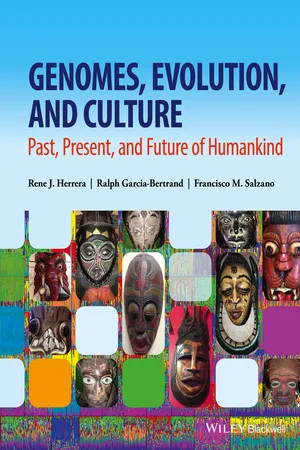Biological Sciences
Genetic Variation
Genetic variation refers to the diversity of genetic material within a population or species. It arises from differences in DNA sequences, such as mutations, genetic recombination, and gene flow. Genetic variation is essential for evolution, as it provides the raw material for natural selection to act upon, leading to the adaptation and survival of species in changing environments.
Written by Perlego with AI-assistance
Related key terms
2 Key excerpts on "Genetic Variation"
- eBook - ePub
Human Variation
Races, Types, and Ethnic Groups
- Stephen Molnar(Author)
- 2015(Publication Date)
- Routledge(Publisher)
chapterThe Biological Basisfor Human Variation2The journey from the discovery of particulate inheritance to the definition of gene structure has been a long one, occupying most of the last century. From simple observations of inheritance between generations of easily perceived traits to descriptions of the chemical nature of the gene (DNA), we have witnessed an explosion of biochemical data on cell function and control of metabolic processes. Over this time period, assisted by evermore sophisticated techniques, we are able to view inheritance at several levels: trait transmission between generations, gene and gene combinations, and the molecular or biochemical structure.With our new-found knowledge it is all too easy to forget or even to ignore some of the key landmarks along the road leading to an understanding of the biological basis for human variation. Many of these landmarks are fundamental for comparisons of population diversity, and it is best to refresh our memory from time to time if we are to appreciate the new molecular genetic discoveries and their meanings for human adaptations to our changing environments.First, recall that humans share similar modes of reproduction with most other mammals, and inheritance mechanisms are the same—the combination of certain materials from the germ cells of male and female parents to produce a fertilized egg. These mechanisms of inheritance are the source of much of the vast diversity seen in the biological world. For many centuries, natural scientists had sought to comprehend and explain this diversity in the transmission of traits between generations. Explanations varied from a description of a “blending” of parental bloodlines, favored by animal husbandry, to a theory of “preformism,” the idea that the individual, in miniature form, existed in either the ovum or sperm awaiting stimulation by fertilization to begin its development. None of these explanations could account for the ranges of individual similarities or differences among offspring and their parents. - eBook - ePub
Genomes, Evolution, and Culture
Past, Present, and Future of Humankind
- Rene J. Herrera, Ralph Garcia-Bertrand, Francisco M. Salzano(Authors)
- 2016(Publication Date)
- Wiley-Blackwell(Publisher)
Chapter 4 Genetic VariabilityAt bottom every man knows well enough that he is a unique being, only once on this earth; and by no extraordinary chance will such a marvelously picturesque piece of diversity in unity as he is, ever be put together a second time.—Friedrich Nietzsche [1]Summary
A number of forces act at the population level to shape gene pools. Mutations, the raw material of evolution, are the sources of variability that are then acted on by mechanisms that alter the abundance of genetic variants. These forces include genetic drift, selection, bottleneck events, founder effects, isolation, nonrandom mating, and inbreeding. Mutations, for the most part, occur at random throughout the genome and happen spontaneously or can be induced by chemicals or radiation. DNA areas rich in repetitive sequences, short tandem repeats (STRs), and GpC dinucleotides experience elevated mutation rates. Some mutations are subject to natural selection, yet others are selectively neutral or almost neutral. Mutations that are under selection pressure usually are retained in genomes as a result of balanced polymorphisms in which positive and negative selection pressures reach a state of dynamic equilibrium. In the state of balanced polymorphisms, heterozygotes have a higher fitness than both homozygotes, and directional selection occurs when one homozygote is favored (positive selection) compared with the other (negative selection). Sickle-cell anemia is a classical example. Neutral mutations are particularly useful in studies of genetic variability since they represent markers that reflect true ancestry more faithfully. The phenotype not only is dictated by our DNA but always has an environmental component. Mutations occur in somatic or germline tissues with different consequences, the former being a contributor to the genesis of cancer and the latter as a source of evolutionary change. The environment is never constant and since selection pressure affects allelic frequencies of many genes, the frequencies of specific genetic variants fluctuate. These selection-driven alterations in allelic frequencies may obscure the true phylogenetic relationships among groups of organisms.
Learn about this page
Index pages curate the most relevant extracts from our library of academic textbooks. They’ve been created using an in-house natural language model (NLM), each adding context and meaning to key research topics.

